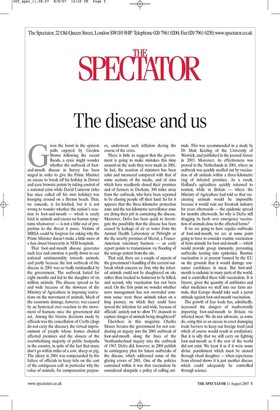The disease and us Civen the boost in the opinion
polls enjoyed by Gordon Brown following the recent floods, a cynic might wonder whether the outbreak of footand-mouth disease in Surrey has been staged in order to give the Prime Minister an excuse to break off his holiday in Dorset and earn brownie points by taking control of a national crisis while David Cameron (who has since called off his own holiday) was lounging around on a Breton beach. That, we concede, is far-fetched, but it is not wrong to wonder whether the nation's reaction to foot-and-mouth — which is rarely fatal in animals and causes no human symptoms whatsoever — is not a little out of proportion to the threat it poses. Victims of MRSA could be forgiven for asking why the Prime Minister doesn't make a little more of a fuss about biosecurity in NHS hospitals.
That foot-and-mouth disease generates such fear and emotion is partly down to our national sentimentality towards animals, and partly because the last outbreak of the disease in 2001 was so badly mishandled by the government. The outbreak lasted for eight months and led to the slaughter of six million animals. The disease spread so far and wide because of the slowness of the Ministry of Agriculture in imposing restrictions on the movement of animals. Much of the economic damage, however, was caused by an hysterical over-reaction to the movement of humans once the government did act. Among the bizarre decisions made by officials was the cancellation of Crufts (dogs do not carry the disease), the virtual imprisonment of people whose homes abutted affected premises and the closure of the overwhelming majority of public footpaths in the country, in spite of the fact that many don't go within miles of a cow, sheep or pig. The idiocy in 2001 was compounded by the failure of officials to keep tabs on the cost of the contiguous cull: in particular why the value of animals, for compensation purpos es, underwent such inflation during the course of the crisis.
There is little to suggest that the government is going to make mistakes this time around on the scale they were made in 2001. In fact, the reaction of ministers has been calm and measured compared with that of some sections of the media, and of zoos which have needlessly closed their premises and of farmers in Durham, 300 miles away from the outbreak, who have been reported to be chasing people off their land. So far it appears that the three-kilometre protection zone and the ten-kilometre surveillance zone are doing their job in containing the disease. Moreover, Defra has been quick to investigate the possibility that the disease has been caused by leakage of air or water from the Animal Health Laboratory at Pirbright or the the nearby premises of Merial, a FrancoAmerican veterinary business — an early report points to transmission via flooding of the sewage system from the site.
That said, there are a couple of aspects of the government's handling of the current outbreak which concern us: first, why the infected animals could not be slaughtered on site rather than trucked to Somerset to be killed, and second, why vaccination has not been used. On the first point we wonder whether news management has not overruled common sense: were these animals taken on a long journey, on which they could have spread the infection far and wide, because of officials' anxiety not to allow TV channels to capture images of animals being slaughtered?
Elsewhere in this magazine Charles Moore berates the government for not conducting an inquiry into the 2001 outbreak of foot-and-mouth along the lines of the Northumberland inquiry into the outbreak of 1967. Defra did, however, in 2004 publish its contingency plan for future outbreaks of the disease, which addressed some of the glaring errors of 2001. One of the policies contained within it was that vaccination be considered alongside a policy of culling ani mals. This was recommended in a study by Dr Matt Keeling of the University of Warwick, and published in the journal Nature in 2003. Moreover, its effectiveness was proved in the Netherlands in 2001, where an outbreak was quickly snuffed out by vaccination of all animals within a three-kilometre ring of infected premises. As a result, Holland's agriculture quickly returned to normal, while in Britain — where the Ministry of Agriculture had told us that vaccinating animals would be impossible because it would ruin our livestock industry for years afterwards — the epidemic spread for months afterwards. So why is Defra still dragging its heels over emergency vaccination of animals close to the affected farms?
If we are going to have regular outbreaks of foot-and-mouth, we are at some point going to have to consider routine vaccination of farm animals for foot-and-mouth — which would provide group immunity, preventing outbreaks turning into epidemics. Routine vaccination is at present banned by the EU on the grounds that it would damage consumer confidence in meat. But foot-andmouth is endemic in many parts of the world, and is controlled there with vaccination. It is bizarre, given the quantity of antibiotics and other medicines we stuff into our farm animals, that Europe should take such a purist attitude against foot-and-mouth vaccination.
The growth of free trade has, admittedly, increased the dangers of inadvertently importing foot-and-mouth to Britain via infected meat. We do not advocate, as some do, using this as an excuse to erect damaging trade barriers to keep out foreign food (and which of course would result in retaliation). But it is silly that we still carry on fighting foot-and-mouth as if the rest of the world did not exist. We treat it as if it were some divine punishment which must be atoned through ritual slaughter — when experience from abroad shows it is just another disease which could adequately be controlled through science.









































 Previous page
Previous page